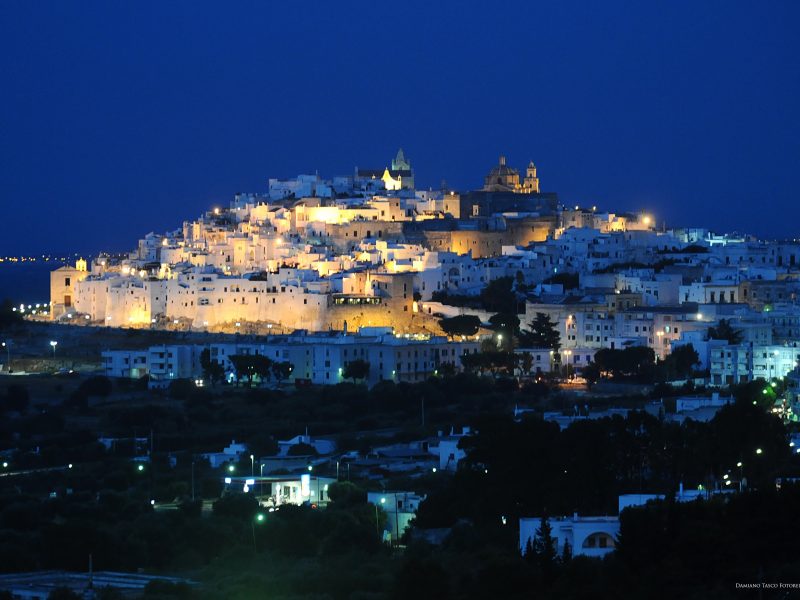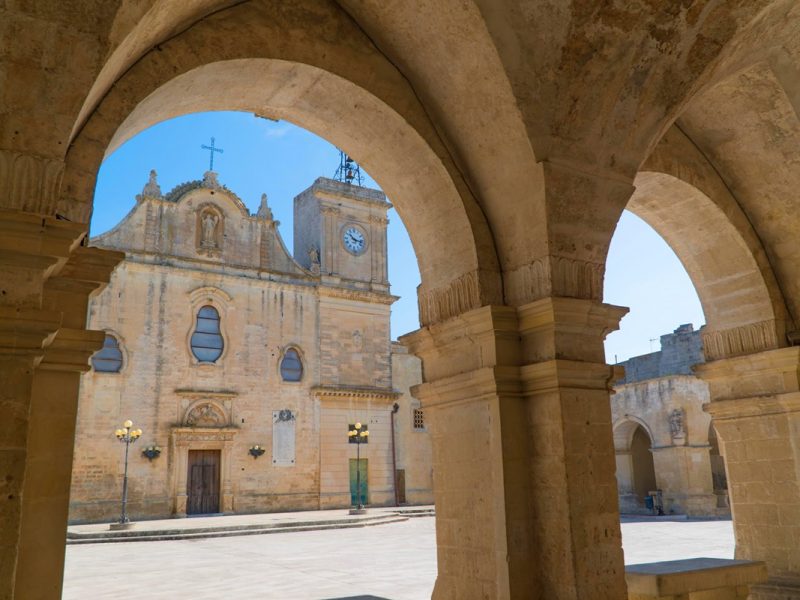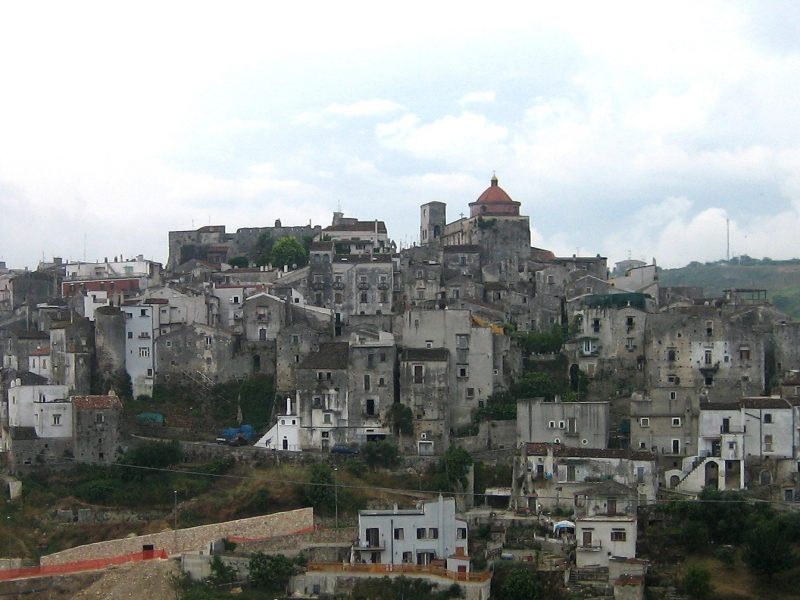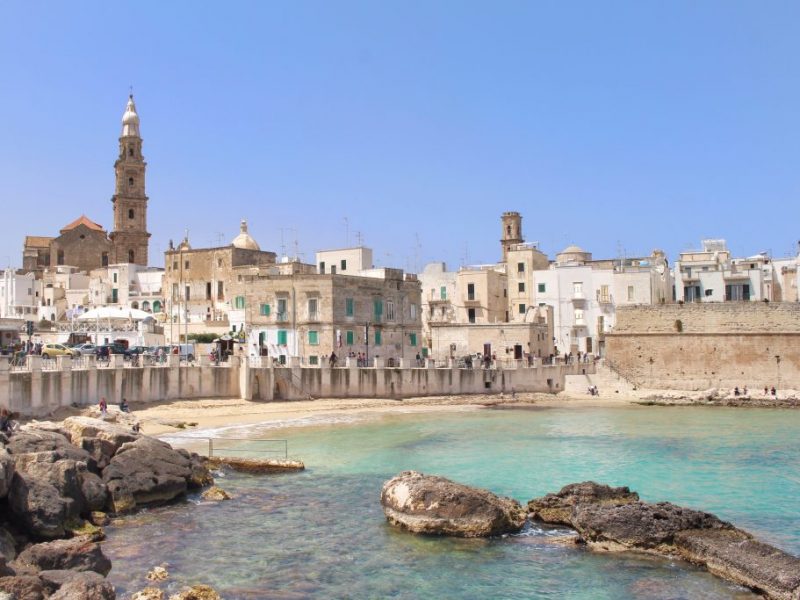The Borgo of Manduria
“Primitivo” wine has accompanied meals in Puglia for centuries. It is the region’s undisputed favorite because of its decisive and intense character, so much like the nature of this vibrant land and its high-spirited people. Manduria is surrounded by the vineyards that produce Primitivo and this magnificent wine is the pride of the borgo and what it is most famous for. Manduria is small and gracious, protected by thick, fortified walls that have been guarding it for thousands of years, a living testament to the ancient origins of this borgo.
The Bay of San Pietro is bathed by the crystalline sea, its nearby defensive tower protecting the salt flats of the Benedictine monks, which are home to the flocks of rare and marvelous pink flamingos who gracefully pass their days here, a delightful spectacle to behold. Numerous visitors come to observe them from afar, so as not to disturb the tranquility of their natural habitat.
Manduria is a place of myth and legend, casting a spell of fascination and intrigue: Did “Plinian’s Well” really host a chicken with a golden egg? Did St. Peter truly stop here to quench his thirst at the River Bevagna? Perhaps it is true, perhaps not. Sometimes, the beauty of a legend is simply letting ourselves believe it, without bothering to ask why. And when in doubt, bring on another glass of Primitivo from Manduria!
Still today, Manduria enjoys the prestige of having been an ancient Messapian city. Messapia, or Messapica, meaning “the land bathed by two seas” was a powerful and highly civilized nation with strong cultural and commercial ties to Ancient Greece. It had its own government and monetary system and serenely ruled southern Puglia from 800 B.C. to 200/300 B.C. The traces of Manduria’s glorious past can be admired as soon as you reach the entrance to the city, which is surrounded by thick, fortified walls and a moat dating back to several centuries before the birth of Christ. From its genesis, Manduria was a rival of nearby Taranto, an extremely powerful port city, and they clashed in numerous battles. In 260 B.C. the borgo came under Roman domination, but when the Corinthian general Hannibal crossed the Alps to attack Rome in 218 B.C., the Mandurians did not hesitate to support him. As a result, Manduria was subjected to violent repression by a vindictive Rome in all its fury.
Manduria is one of the cities along the historic road known as the “Via Traiana”, or “Via Sallentina”, a stone-paved road that is one of the most ancient in all of Italy, which goes in the direction of Nardò, Ugento and Otranto.
With the fall of the Roman Empire, the territory of Manduria was hit by an onslaught of violent attacks by barbarians and a particularly vicious invasion by the Saracen Turks destroyed the center of the town, which was rebuilt some years later with the new name of Casalnuovo. The new borgo was built on only a part of the original nucleus, with the rest of the new city constructed to the west, as the eastern side was occupied by a Messapian necropolis which has been left untouched and still exists today.
The Medieval period was fraught with strife: the little borgo passed from one powerful feudal family to another, part of the continual power struggle for territory that marked the entire northern region of Puglia during the Middle Ages. It finally came under the dominion of the Imperiali family of Martina Franca, which held control of the feudal territory until the eighteenth century.
Regardless of the passing of time, the population never got used to the name Casalnuovo, and after bringing their cause to King Ferdinand of the Bourbons, on the 17th of November, 1789, a decree was issued to change the official name of the borgo back to Manduria. One century later, by decree of King Umberto I, Manduria was issued the official title of “City”.
Successively, Manduria was caught up in the events related to the Kingdom of Naples, and then, the social uprisings leading to the Unity of Italy.
Over the centuries, an increase in Manduria’s demographic population was halted numerous times by epidemics of cholera and the Plague which decimated the city. In the nineteenth century, especially in the period between the First and Second World Wars and the 1950’s, the birth rate was high, leading to urban expansion and the construction of new residential neighborhoods.
San Pietro in Bevagna
Beaches of fine white sand, crystalline sea, and a river where you can go canoeing in beautiful marshlands are the key attractions that enchant visitors coming to San Pietro in Bevagna, a beach town hamlet about ten kilometers from Manduria.
Summer tourism is not the only attraction in this little town. San Pietro in Bevagna is also reknowned for its historic religious celebrations in honor of St. Peter, San Pietro, held in the first few days of April. It is a traditional festival of extremely ancient origins, dating back to an episode which took place in the year 44 A.D. , featuring none other than St. Peter himself. It is said that Christ’s disciple landed at this beach near Manduria after a shipwreck, and that after he performed Holy Communion, he continued on his mission to spread the message of God. In another version, it is said that St. Peter stopped to quench his thirst at the River Bevagna. Because of this, the water from the river is considered sacred, and every year a solemn ritual is held, blessing all the animals of the town.
San Pietro in Bevagna has dedicated a sanctuary to Christianity’s first pope. It is inside of a cavern, where you can admire a wooden statue of the saint holding fishing nets.
In the territory of Salento, this little town is not the only place boasting the passage of St. Peter. To name only a few, there is San Pietro in Lama and San Pietro Vernotica, where it is said that the saint blessed the water of the well. In Galatina, a stone where he stopped to sit and rest is venerated, and in Nardo, the imprint of his hand in a stone is preserved as a holy relic.
The Archeological Park of Manduria
The Messapian Walls, Plinian’s Well, and the Church of San Pietro Mandurino
The Archeological Park of Manduria is takes up one hundred and fifty thousand square meters and includes three concentric rings of ancient city walls.
Walking along the moat that circles the city is an awe-inspiring experience that has to be lived to be believed. The ancient splendor of Messapian Manduria lives on in this archeological park which totally surrounds the city, thanks to the walls that form three protective rings around it. The most ancient part of the walls dates back to the fifth century B.C., and is composed of irregular shaped stones; the middle wall dates back to the fourth century B.C. and is composed of regular shaped blocks, with the outer wall realized in the third century A.D., substantially larger than the other two constructions.
The need for such a complex defensive structure stemmed from the ancestral rivalry with the nearby city of Taranto, a powerful and dominating force to be reckoned with, which engaged Manduria in numerous battles over the centuries.
Between 1700 and 1800 Manduria was a favorite stop on the “The Grand Tour” of Italy, frequented by wealthy and cultured Europeans. People came from all over the “Continent” to discover the timeless history of this borgo, starting from the ancient and noble Messapians, to the conquest by the Roman Empire, and the arrival of Hannibal from across the Alps. It is no wonder they were fascinated by this ancient city, sacked innumerable times and even destroyed, only to be reborn and begin anew.
The last two blocks of the most recent walls are near the ruins of ancient tombs, of which today remain only rectangular graves dug in the bedrock. A little farther from the walls are tombs that are even more ancient, dating back to the fourth century A.D.
The Archeological Park of Manduria contains two other historical marvels. The first, and most famous, is the “Fonte Pliniano”, Plinian’s Well, and the second is the equally fascinating Church of San Pietro Mandurino.
To visit Plinian’s Well, you must descend into a small cavity, where you will find a surreal place of enchantment: a cavern carved in the rock, with soft light filtering in from above, creating a mystical, otherworldly atmosphere. In the center of the cavern is a small well with an almond tree growing in the center. You can draw water from this well innumerable times but the water level remains exactly the same. Over the centuries, this distinctive characteristic has animated the curiosity of many, in particular the Latin historical scholar “Plinio il Vecchio”, (Plinio the Old), who wrote about the well in his most famous work: De rerum natura. Regardless of the aura of mystery surrounding this place, there is actually nothing mysterious about it. As you descend into the cavern, it is clear that the water level, or sea level, is at the same level as the ground in the cave, hence the explanation.
The “Fonte Pliniano” is not only famous for its infinite waters, but also for the numerous myths and legends surrounding it. Lu scegnu, as it is called in the local dialect, was said to be the home of a large hen who laid golden eggs, who was guarded by a deer. Others maintain that the cavern was the hiding place for a treasure taken from the people of Taranto, and according to yet another legend, the people of Manduria had stolen large amounts of gold from their enemies, from which they created golden almonds to hang on the almond tree. In this tranquil spot, somewhere between truth and legend, Plinian’s Well has conserved the purity of its water and also its timeless fascination.
The Church of San Pietro Mandurino is linked to a local legend that bases its origins back to when St. Peter passed through Manduria. It is a small and modest church, with no grand aspirations, except that of offering the population a place to venerate this saint of saints. It was constructed in the eighth century A.D. over an underground construction dating back to the sixth century A.D. This small construction was probably an ancient tomb, and later transformed into a Christian church.
Torre Colimena- “The Salt Flats of the Benedictine Monks”
Like stars, the ancient towers guide the way along the coasts of Puglia. For centuries they have witnessed the passing of history and listened to the secret voices of the sea. The were all constructed around the year 1500, in a period where Puglia was under constant threat of attacks by the Saracen Turkish pirates, and they remained as faithful guardians of the territory even when the threat was finally quelled.
Some of the towers stand valiantly at the very edge of the sea, others are perched high on the rocky cliffs, set in the Mediterranean foliage. Some have been eroded by the waves of time, others shine proudly in all their original splendor, reflecting the light of the nearby borghi they have always protected.
Of all these magnificent constructions, one of the most beautiful is certainly the Torre Colimena, which was not built as a defensive tower like the others. Torre Colimena faces a natural reserve on the coast of Taranto, and was built to safeguard the salt flats of the Benedictine monks of San Lorenzo.
Today, Torre Colimena is a splendid architectural jewel in a little corner of the world where rare and graceful pink flamingoes, in all their delicate elegance, have made their home, which they share with majestic marshland falcons. Torre Colimena has been restored to its original glory as part of a recuperation project for the entire reserve, where paths have been created throughout this natural paradise to discover the history and the wildlife that abound here. The paths of the reserve lead to capu ti cilona, a sea rock in the form of the head of a turtle, and reach the bay of Torre Colimena, a charming beach town with a bay of golden sand.
The “Fiera Pessima”, The Terrible Fair
“Pessima” in Italian means “extremely bad”, or “terrible” (think: pessimism). Terrible, like the wind and rain that accompanied this fair every year in Manduria. Traditionally, the “Fiera Pessima”
was held at the beginning of March, when winter had not yet loosened its grip and the weather was still harsh and unpredictable. Some maintain that the fair was named for the terrible quality of the goods that were sold there, or because of the difficult years the farmers had, which affected the quality and the quantity of the crops they brought to market. Nothing is certain, except that the “Fiera Pessima”, regardless of its unappealing name, has been held every year for almost three hundred years.
Year by year, the fair has changed with the changing proclivities of the inhabitants and the marketplace: in the past the fair offered terracotta vases, wooden carts and carriages, farm animals and local fruits and vegetables, while today the merchandise is notably different, except for the wonderful local fruits and vegetables as well as other high quality local foods and products, all made in Puglia of course!
In 2017, particular circumstances affecting the city had the citizens of Manduria holding their breath, for it seemed that for the first time, an edition of the “Fiera Pessima” was to be cancelled! In the end, it was simply postponed until September, where for the first time it coincided with the celebration of the patron saint, San Gregorio the Armenian.
Traditional Products
Il Primitivo of Manduria
As you approach Manduria, there are long stretches of vineyards as far as the eye can see. This is the land of “Il Primitivo”, the favorite, and most famous wine of Puglia.
Il Primitivo is a full bodied wine with rich fruit accents that combines perfectly with a wide range of dishes, from first course pastas, to meat or fish, to cheese and fruit plates, Il Primitivo exalts them all. Many of the wineries here have joined to form the “Consorzio Produttori”, the Association of Wine Producers, which can be visited. Inside, you are invited to the “Museo della Civilità del Vino Primitivo”, a museum dedicated to the history and culture of Primitivo wine, where you can participate in guided tours and wine tastings in a beautiful and truly unique location.
Giovanni Dimitri
Giovanni Dimitri was born in Manduria in 1963. He is a member of the Carabinieri armed forces and in 2003 he was awarded a Civil Medal of Honor for saving the lives of two people who were drowning and assisting in finding the body of the third person who had not been rescued in time.
______________________________________
Do you known of any famous people related to this borgo? Contact us!

 Italiano
Italiano
 Deutsch
Deutsch









